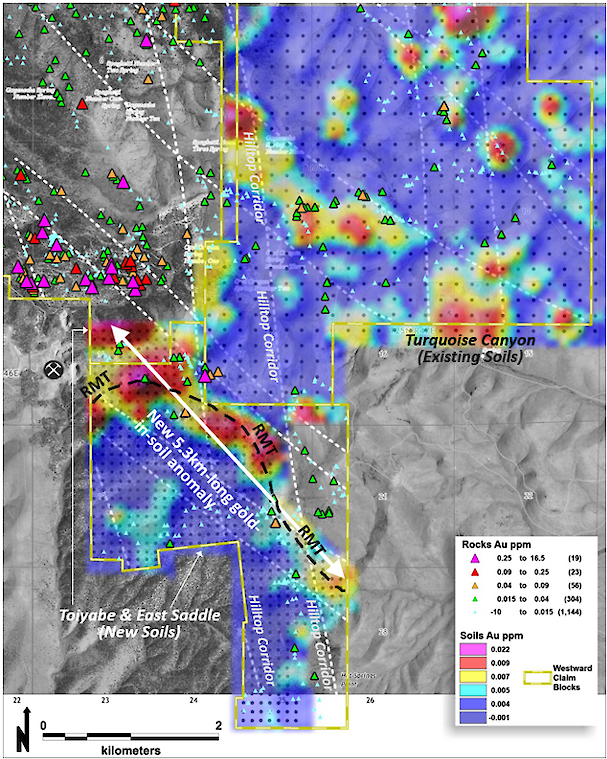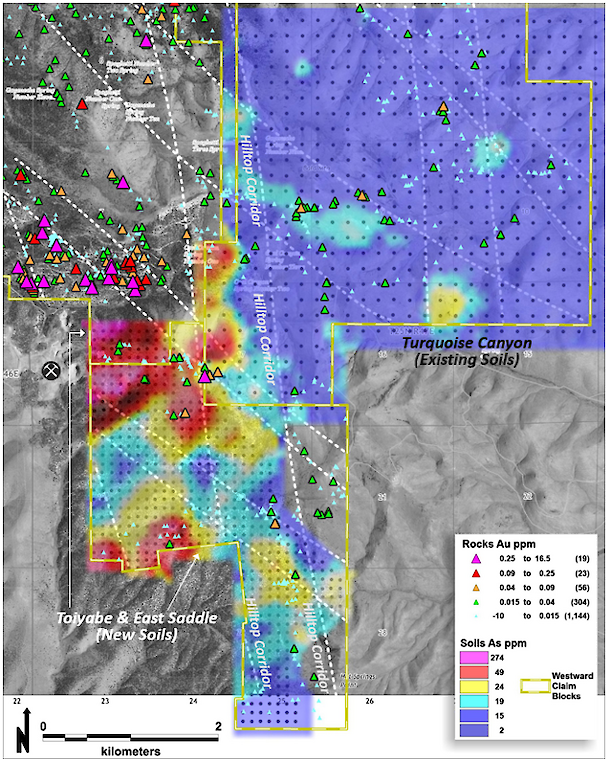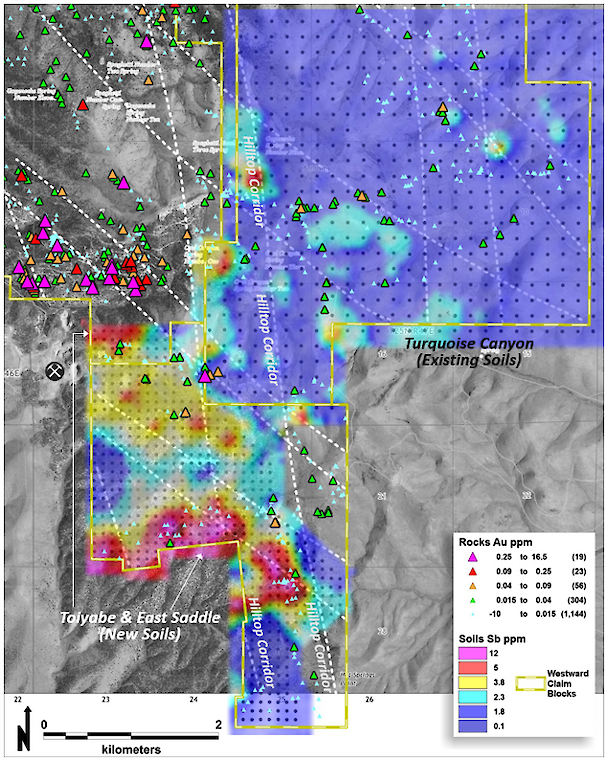Westward Gold Inc. (CSE: WG, OTCQB: WGLIF, FSE: IM50) (“Westward” or the “Company”) is pleased to report gold and multi-element assay results for 606 soil samples collected on the Company’s 100%-owned Toiyabe and East Saddle Properties, situated along the Cortez Trend in Lander County, Nevada. This phase of the survey – conducted at the end of 2023 prior to winter conditions setting in – was primarily designed to extend existing coverage southward over the exposed lower-plate carbonate window at East Saddle, and adjacent portions of the overlying upper-plate siliciclastic formations due east of the past-producing Toiyabe-Saddle Mine open pits. The soil samples were collected at nominal 100-meter spacings, and have been integrated into existing soil datasets from the Turquoise Canyon Property.
These new results, which represent an important step in covering all previously-unsampled ground on the Company’s consolidated ~40 square kilometer land package, will be added to in the coming months as the fulsome grid is completed. Vice President Exploration Robert Edie has recently returned from the Company’s properties, and ground conditions are now sufficiently favourable to kick off planned 2024 exploration activities (described in detail in Westward’s press release dated February 27, 2024).
Key Highlights:
- Strong signs of large, zoned geochemical footprints often indicative of significant Carlin-type gold deposits in the subsurface
- An expansive, newly-mapped zone of elevated gold-in-soil anomalies includes the entire strike length of the Roberts Mountains Thrust (“RMT”) Fault at East Saddle (see Figure 1)
- New positive results will guide upcoming exploration activities focused on drill-target selection, including detailed surface mapping, geophysical surveys, and additional rock-chip and soil sampling
Robert Edie, Westward’s Vice President Exploration, commented: “The results of this phase of our soil sampling program continue to improve our insight into the stratigraphic and structural controls on gold at our properties. With this enhanced understanding we can vector into the highest-priority targets for drilling, while mitigating risks and maximizing potential for success when drill dollars are deployed.”
Kelly Cluer, Strategic Advisor to the Company, added: “The general geology indicates that major strata of the lower and upper plates dip gently to the east in the area of the new soil array. This indicates that significant portions of the large geochemical footprint are preserved under relatively shallow cover, and coincide with major geophysically-imaged structural corridors – an ideal setting for new discoveries.”
Figure 1: Gold-in-Soils & Rock Chip Samples at Westward’s Consolidated Properties

Figure 1 above highlights an extensive new zone of anomalous gold-in-soil values, which also contains anomalous gold in rock-chip samples. The white dotted lines represent simplified structural fabric as evidenced by existing geophysical surveys, mapping, and lineament analysis. Additionally, the RMT Fault is a significant controlling structure.
The gold anomaly in upper-plate rocks displays a pronounced NW-SE trend, is approximately 400 to 700 m wide, and extends from historic mining areas for approximately 5.3 km (3.4 km at strong amplitudes with a further 1.9 km at lower amplitudes). The anomaly closely tracks the surface expression of the RMT Fault, is controlled by both NW-SE and N-S fabric, and remains open to the southeast beyond the limits of the sampling program conducted. This zone is structurally complex, contains numerous multielement geochemical anomalies (including those typically referred to as Carlin-suite elements), as well as a gravity horizontal gradient feature potentially indicating a deep-seated fault zone (further described in the Company’s February 27, 2024 press release). Fault-related damage zones in this corridor (the “Hilltop Corridor”) are thought to have structurally prepared the carbonate host rocks making them susceptible to Carlin-type gold deposition.
Figure 2: Arsenic-in-Soil Samples at Westward’s Consolidated Properties

Figure 2 above, highlighting robust arsenic plumes mapped in the soil grid east of historic mining areas and along structural trends, further enhances a broad target zone which has never been drilled. Arsenic is a key pathfinder element for Carlin-type gold deposits in this geological setting. Notably, arsenic-in-soil values decrease to the east, likely indicative of a gradual eastward thickening of upper-plate lithologies that effectively attenuate geochemical signals. Despite this directional weakening however, the anomalous arsenic feature is apparent over 5+ km and remains open to the east, which speaks to its scale.
Figure 3: Antimony-in-Soil Samples at Westward’s Consolidated Properties

Beyond the southern arsenic anomaly, an antimony anomaly displayed in Figure 3 above continues for an additional 600 m, further enhancing the prospective nature of this corridor. The Company plans to complete detailed Anaconda-style geological mapping in this area as a near-term priority, as it aims to further delineate and reinforce compelling new drill targets based on a multitude of datasets.
Overall, these new soil geochemical assay results demonstrate that the footprint of a large mineralizing system continues to grow as the Company pushes the boundaries of high-quality data collection outward over its entire consolidated land package. Certain anomalies remain open along strike and require further expansion of field data collection; Westward is excited to begin this important work and launch the 2024 exploration season.
Sampling Methodology, Chain of Custody, Quality Assurance / Quality Control (“QA/QC”)
The Company implemented a best-practices QA/QC program during the surface sampling program. All soil samples were collected by Robert Edie, Westward’s Vice President Exploration and one independent contractor working under Robert Edie’s supervision. Robert Edie was on-site throughout the fieldwork campaign and transported all samples personally. The average weight of each sample was 0.35 kilograms. Coordinates for each sample were collected by Garmin GPS units in datum UTM NAD 83 Zone 11 meters and recorded in a spreadsheet. Soil samples were transported from the field collection areas by Robert Edie to his home in Zephyr Cove, NV, and then to ALS’ certified laboratory at 4977 Energy Way, Reno, NV 89502. There, the samples were crushed and pulverized; resulting sample pulps (30g sample weight for gold and 500mg for multielement) were analyzed by ALS Reno for gold at 4977 Energy Way, Reno, NV, 89502 and ALS Vancouver for multielement at 2103 Dollarton Hwy, North Vancouver, BC, Canada. ALS is independent of the Company. Certified reference materials (“CRMs”) purchased from Moment Exploration Geochemistry in Lamoille, NV, were inserted into the soil sample stream at a frequency of one every 25th sample (4%). Four CRMs were inserted at random, three with known gold values, and one certified blank. All results were deemed to be within acceptable analytical limits for disclosure.
Option Grant
Westward also announces that it has approved and granted an aggregate of 205,000 stock options (the “Options”) to various consultants of the Company. The Options, which vest immediately, are exercisable at a price of C$0.12 per common share of the Company for a period of two (2) years from the date of grant.
Qualified Person
The technical information contained in this news release was reviewed and approved by Robert Edie, Vice President Exploration of the Company, who is a Qualified Person under National Instrument 43-101 – Standards of Disclosure for Mineral Projects. Mr. Edie is a Certified Professional Geologist (CPG) through the American Institute of Professional Geologists (AIPG).
About Westward Gold
Westward Gold is a mineral exploration company focused on developing the Toiyabe, Turquoise Canyon, and East Saddle Projects located in the Cortez Hills area of Lander County, Nevada, and the Coyote and Rossi Projects located along the Carlin Trend in Elko County, Nevada. From time to time, the Company may also evaluate the acquisition of other mineral exploration assets and opportunities.
For further information contact:
Andrew Nelson
Chief Financial Officer
Westward Gold Inc.
+1 (604) 828-7027
andrew@westwardgold.com
www.westwardgold.com
The Canadian Securities Exchange has neither approved nor disapproved the contents of this news release. The Canadian Securities Exchange does not accept responsibility for the adequacy or accuracy of this news release.
This news release contains or incorporates by reference “forward-looking statements” and “forward-looking information” as defined under applicable Canadian securities legislation. All statements, other than statements of historical fact, which address events, results, outcomes, or developments that the Company expects to occur are, or may be deemed, to be, forward-looking statements. Forward-looking statements are generally, but not always, identified by the use of forward-looking terminology such as "expect", "believe", "anticipate", "intend", "estimate”, “potential”, “on track”, “forecast", "budget", “target”, “outlook”, “continue”, “plan” or variations of such words and phrases and similar expressions or statements that certain actions, events or results “may”, “could”, “would”, “might” or “will” be taken, occur or be achieved or the negative connotation of such terms.
Such statements include, but may not be limited to, information as to strategy, plans or future financial or operating performance, such as the Company’s expansion plans, project timelines, expected drilling targets, and other statements that express management’s expectations or estimates of future plans and performance.
Forward-looking statements or information are subject to a variety of known and unknown risks, uncertainties and other factors that could cause actual events or results to differ from those reflected in the forward-looking statements or information, including, without limitation, the need for additional capital by the Company through financings, and the risk that such funds may not be raised; the speculative nature of exploration and the stages of the Company’s properties; the effect of changes in commodity prices; regulatory risks that development of the Company’s material properties will not be acceptable for social, environmental or other reasons, availability of equipment (including drills) and personnel to carry out work programs, that each stage of work will be completed within expected time frames, that current geological models and interpretations prove correct, the results of ongoing work programs may lead to a change of exploration priorities, and the efforts and abilities of the senior management team. This list is not exhaustive of the factors that may affect any of the Company’s forward-looking statements or information. These and other factors may cause the Company to change its exploration and work programs, not proceed with work programs, or change the timing or order of planned work programs. Additional risk factors and details with respect to risk factors that may affect the Company’s ability to achieve the expectations set forth in the forward-looking statements contained in this news release are set out in the Company’s latest management discussion and analysis under “Risks and Uncertainties”, which is available under the Company’s SEDAR+ profile at www.sedarplus.ca. Although the Company has attempted to identify important factors that could cause actual results to differ materially, there may be other factors that cause results not to be as anticipated, estimated, described or intended. Accordingly, readers should not place undue reliance on forward-looking statements or information. The Company’s forward-looking statements and information are based on the assumptions, beliefs, expectations, and opinions of management as of the date of this press release, and other than as required by applicable securities laws, the Company does not assume any obligation to update forward-looking statements and information if circumstances or management’s assumptions, beliefs, expectations or opinions should change, or changes in any other events affecting such statements or information.
